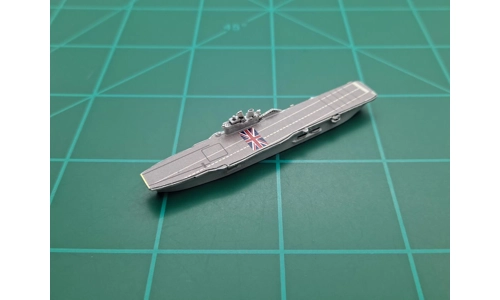
Majestic Class Light Aircraft Carrier
Product Details
- Majestic Class Light Aircraft Carrier
- CVL-MAJESTIC-HBG-RAN-P
-
- Units in Stock: 5
Majestic Class Light Aircraft Carrier Summary
This is a 3D printed sculpt of the Majestic aircraft carrier by HBG.Experiences during the early part of World War II had demonstrated the need for defensive air cover for fleets and convoys which could only be provided by aircraft carriers. In order to obtain adequate air coverage, more carriers were needed. In mid-1941 the British investigated how best to achieve this without the lengthy construction times normally associated with carriers. The options were to convert existing Hawkins-class cruisers with a flight deck, convert additional merchant vessels and passenger liners, or create a new design for a cheap, lightly armed, and unarmoured ship similar to the American escort carriers. In December 1941, it was decided that a new design was the best option. The new design was called the Light Fleet Carrier, and was used by eight naval forces between 1944 and 2001.
Sixteen Light Fleet Carriers were ordered named the Colossus class, and all were laid down between 1942 and 1943. Only eight were completed to this design, and of these, four entered service before the end of the war, though none saw front line operations. Two more were fitted with maintenance and repair facilities instead of aircraft catapults and arresting gear, and entered service as aircraft maintenance carriers. The final six were modified during construction to handle larger and faster aircraft, and were re-designated as the Majestic class. The construction of the six ships was suspended at the end of the war. Five were eventually completed with the last commissioning in 1961. The sixth, Leviathan, was dismantled for spare parts and scrap.
Although not completed in time to participate in WW2, the carriers participated in the Korean War and the Suez Crisis. During the latter, two Colossus-class ships performed the first ship-based helicopter assault in history. Four Colossuses and all five completed Majestics were loaned or sold to seven foreign nations – Argentina, Australia, Brazil, Canada, France, India, and the Netherlands – with three ships serving in three different naval forces during their careers. Foreign-operated Light Fleets took part in the Korean War, the First Indochina War, the Vietnam War, the Indo-Pakistani War of 1971, and the Falklands War.
Despite being intended as 'disposable warships', all of the completed Light Fleet carriers exceeded their planned three-year service life. The maintenance carriers were the first to be paid off in the 1950s, and by the 1960s, all of the Royal Navy carriers, (bar Triumph, which was later recommissioned as a repair ship) had been sold to other nations or for ship breaking. The carriers in other navies had longer service lives. At the time of her decommissioning in 2001, Minas Gerais was the oldest active aircraft carrier in the world. Despite attempts to preserve several of these carriers as museum ships, the last surviving example, Vikrant, was sold for scrapping in 2014.
Ships of Class:
- Ocean (Colossus class)
- Melbourne
- Sydney
- Vengeance (Colossus class)
The optional magnetized damage marker makes a great game addition.

Approximate dimensions (LWD): 64.3mm x 11mm x 12.7mm

Updating Order Details
Please do not refresh or navigate away from the page!
Customer Reviews
No Reviews Posted Yet - be the first!
(write review)
